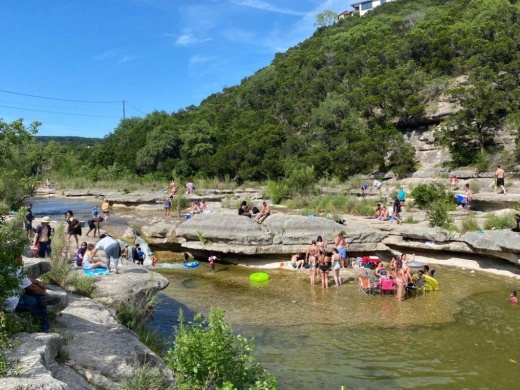The city of Austin is investigating a potentially harmful algae bloom at The Bull Creek Preserve after receiving a report Aug. 5 that a swimmer developed symptoms associated with algae exposure.
Austin’s Watershed Protection Department said it cannot confirm the presence of toxic algae at Bull Creek or whether the illness was the result of algae exposure, according to an Aug. 6 news release. The situation is considered an active investigation.
The department collected water and algae samples the morning of Aug. 6, and preliminary lab results are expected later this week, which will confirm or deny the presence of toxins. Blue-green algae, more accurately referred to as cyanobacteria, occurs naturally in Central Texas and global water bodies. However, under certain environmental conditions, cyanobacteria species can produce toxins that are dangerous to people and animals when ingested.
“It is impossible to tell if toxins are present by looking at algae, so assume that all algae may have toxins and avoid direct contact,” the department said in the release.
The release did not specify details of the swimmer’s illness, but common symptoms of toxic algae exposure include fever, headache and eye irritation as well as gastrointestinal, neurologic and respiratory signs.
Locally, blue-green algae has also been connected to the death of dogs. The city of Austin is aware of five dogs who died after swimming in Lady Bird Lake in 2019. Similarly, west of Austin, the Lower Colorado River Authority reported multiple dogs had fallen ill earlier this year after swimming in Lake Travis. In dogs, symptoms of algae exposure can include vomiting, excessive drooling and respiratory paralysis, among other ailments.
Following these incidents, both the city of Austin and the LCRA have been regularly updating the community on the presence of blue-green algae in local waterways. Samples collected from Red Bud Isle on July 20 detected low levels of dihydroanatoxin, a toxin emitted by cyanobacteria, according to Austin’s Aug. 6 update. The city is continuing biweekly monitoring of Lady Bird Lake and Lake Austin and will display results on online dashboards.
“To date, the city of Austin has only detected toxins in mats of algae that can be found growing on the bottom of the lake or floating on the surface,” the release stated.
Based on those results, the city said toxic algae exposure would occur after touching or swallowing visible algae. Austin is encouraging the public to report signs of exposure in people or pets by calling 311 or 512-974-2000.





